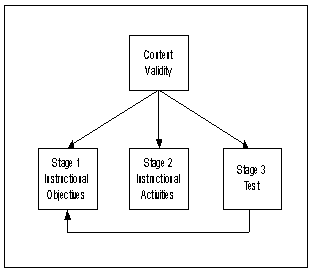
Mark Wilson (2004) Mahwah NJ: Lawrence Erlbaum Associates
The plot-line of "Constructing Measures" is straight-forward. The first chapter presents "A Constructivist Approach to Measurement" outlining four building blocks. These four blocks are the topics of the next four chapters: construct maps, item design, outcome space (i.e., the data and its structure), and the measurement model. The next three chapters focus on specific aspects of instrument quality: model-data fit, measurement error and evidence of test validity. The last chapter connects the topics in the book to the wider worlds of psychology, statistics and assessment.
In total, this book is an excellent text for those desiring to construct, apply and benefit from valid test instruments for measuring educational or psychological traits. The book contrasts strongly with the typical text on educational and psychological testing and measurement. Such texts contain a mass of technical detail and jargon, but lack the careful guidance the neophyte requires to successfully construct a test. A parallel is a book of cooking recipes. The novice cook sees what the final result should look like from the picture and also sees the list of ingredients, but cannot get successfully from the one to the other. "Constructing Measures" guides the reader safely along the rocky path.
Test items must validly measure the instructional objectives

Fig. 1. The 4 building blocks of Wilson, 2004, Fig. 1.9

Test items must validly measure the instructional objectives
Fig. 2. The three-stage classroom measurement model of Kubiszyn and Borich, 2000, Fig. 4.1
The power of the practical, yet deeply philosophical, test-development model central to "Constructing Measures" is obvious when compared with models presented in conventional textbooks. "Constructing Measures" presents a development cycle, Fig. 1, with clearly specified actions to be taken at each stage. The process is one of incremental improvement of every block. The cycle is repeated until the desired results are obtained. A conventional model, such as that in Fig.2, implies a development cycle, but one in which only the test items change, all else is fixed. It operationalizes the "pile-up" theory of respondent performance. The test is a check-list, and respondent success is counted up from "none" to "all". At any moment, each respondent has a certain accumulation, but there is little information about what should be accumulated next, or whether there are holes in the pile.. In contrast, Fig. 1 supports a "ladder" theory of respondent success. At any moment each respondent is at a certain height. We know what is above the respondent and what is below. We can identify the respondent's special strengths and deficits. Further, Fig 1 contains the fundamental insight that, during the test development process, our understanding of the instructional objectives and activities, i.e., the formal statement of the construct, will change. Gaps, obscurities and ambiguities will be encountered. The formal test probes the respondents, but Fig 1. also asserts that their responses probe the construct.
Accompanying the book is the computer program ConstructMap (formerly GradeMap). This features graphical representations of the construct, the functioning of the items, and the response patterns of individual respondents. At the time of this review, ConstructMap (formerly GradeMap) produced conceptually interesting output, but was somewhat slow.
A couple of slight improvements to the text: first, Wright & Masters (1981) should be (1982). More fundamentally, page 4, "1.1 What is Measurement?", contains the enigmatic phrase, "those numbers [measures] have certain properties." It is not until we get to page 92 (in my reading of the text) that the essential property is revealed: "the difference between them is what matters" (Emphasis author's), i.e., the numbers must have linear scaling. In fact, a central purpose of the book is to instruct the reader how to design tests that locate the performance of each person and the difficulty of each item on a shared linear measurement ruler.
This title is currently on offer at $29.95. Its contents complement "Applying the Rasch Model" (Bond & Fox, 2001, Erlbaum).
John Michael Linacre
Book review: Constructing Measures: An Item Response Modeling Approach (M. Wilson), Linacre J … Rasch Measurement Transactions, 2004, 18:3 p. 986
| Forum | Rasch Measurement Forum to discuss any Rasch-related topic |
Go to Top of Page
Go to index of all Rasch Measurement Transactions
AERA members: Join the Rasch Measurement SIG and receive the printed version of RMT
Some back issues of RMT are available as bound volumes
Subscribe to Journal of Applied Measurement
Go to Institute for Objective Measurement Home Page. The Rasch Measurement SIG (AERA) thanks the Institute for Objective Measurement for inviting the publication of Rasch Measurement Transactions on the Institute's website, www.rasch.org.
| Coming Rasch-related Events | |
|---|---|
| Jan. 16 - Feb. 13, 2025, Fri.-Fri. | On-line workshop: Rasch Measurement - Core Topics (E. Smith, Winsteps), www.statistics.com |
| Apr. 8 - Apr. 11, 2026, Wed.-Sat. | National Council for Measurement in Education - Los Angeles, CA, ncme.org/events/2026-annual-meeting |
| Apr. 8 - Apr. 12, 2026, Wed.-Sun. | American Educational Research Association - Los Angeles, CA, www.aera.net/AERA2026 |
| May. 15 - June 12, 2026, Fri.-Fri. | On-line workshop: Rasch Measurement - Core Topics (E. Smith, Winsteps), www.statistics.com |
| June 19 - July 25, 2026, Fri.-Sat. | On-line workshop: Rasch Measurement - Further Topics (E. Smith, Winsteps), www.statistics.com |
The URL of this page is www.rasch.org/rmt/rmt183c.htm
Website: www.rasch.org/rmt/contents.htm